
Limestone is a common type of carbonate sedimentary rock. It is composed mostly of the minerals calcite and aragonite, which are different crystal forms of calcium carbonate. Limestone forms when these minerals precipitate out of water containing dissolved calcium. This can take place through both biological and nonbiological processes, though biological processes have likely been more important for the last 540 million years. Limestone often contains fossils, and these provide scientists with information on ancient environments and on the evolution of life.

Flint is a sedimentary cryptocrystalline form of the mineral quartz, categorized as the variety of chert that occurs in chalk or marly limestone. Flint was widely used historically to make stone tools and start fires.
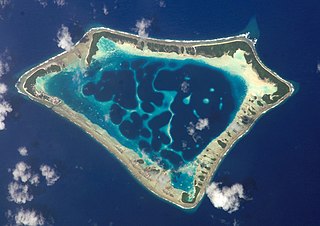
An atoll, sometimes known as a coral atoll, is a ring-shaped coral reef, including a coral rim that encircles a lagoon partially or completely. There may be coral islands or cays on the rim.

Corals are marine invertebrates within the class Anthozoa of the phylum Cnidaria. They typically form compact colonies of many identical individual polyps. Coral species include the important reef builders that inhabit tropical oceans and secrete calcium carbonate to form a hard skeleton.

Coral Castle is an oolite limestone structure created by the Latvian-American eccentric Edward Leedskalnin (1887–1951). It is located in unincorporated territory of Miami-Dade County, Florida, between the cities of Homestead and Leisure City. The structure comprises numerous megalithic stones, mostly limestone formed from coral, each weighing several tons. It is currently a privately operated tourist attraction. Coral Castle is noted for legends surrounding its creation that claim it was built single-handedly by Leedskalnin using reverse magnetism or supernatural abilities to move and carve numerous stones, each weighing many tons.

Lisianski Island is one of the Northwestern Hawaiian Islands, with a land area of 384.425 acres (155.571 ha) and a maximum elevation of 40 feet (12 m) above sea level. It is a low, flat sand and coral island about 905 nautical miles (1,676 km) northwest of Honolulu. The island is surrounded by reefs and shoals, including the extensive Neva Shoals. Access to the island is limited by helicopter or by boat to a narrow sandy inlet on the southeastern side of the island.

Scleractinia, also called stony corals or hard corals, are marine animals in the phylum Cnidaria that build themselves a hard skeleton. The individual animals are known as polyps and have a cylindrical body crowned by an oral disc in which a mouth is fringed with tentacles. Although some species are solitary, most are colonial. The founding polyp settles and starts to secrete calcium carbonate to protect its soft body. Solitary corals can be as much as 25 cm (10 in) across but in colonial species the polyps are usually only a few millimetres in diameter. These polyps reproduce asexually by budding, but remain attached to each other, forming a multi-polyp colony of clones with a common skeleton, which may be up to several metres in diameter or height according to species.
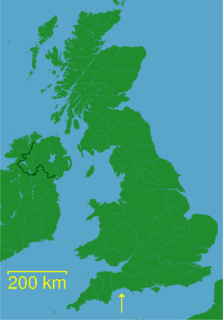
Lyme Bay is an area of the English Channel off the south coast of England, situated between Start Point in the west and Portland Bill in the east. The south western counties of Devon and Dorset front onto the bay.
In the geologic timescale the Bathonian is an age and stage of the Middle Jurassic. It lasted from approximately 168.3 Ma to around 166.1 Ma. The Bathonian age succeeds the Bajocian age and precedes the Callovian age.

Hoi Ha is a place and a village on the innermost shore of Hoi Ha Wan, Hong Kong. It is at the north of Pak Sha O in the Sai Kung Peninsula.
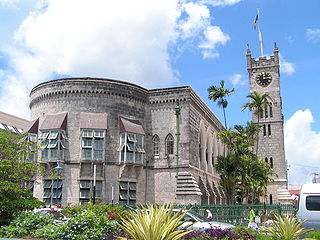
Coral rag is a rubbly limestone composed of ancient coral reef material. The term also refers to the building blocks quarried from these strata, which are an important local building material in areas such as the coast of East Africa and the southeastern United States littoral.

A coral island is a type of island formed from coral detritus and associated organic material. It occurs in tropical and sub-tropical areas, typically as part of a coral reef which has grown to cover a far larger area under the sea.
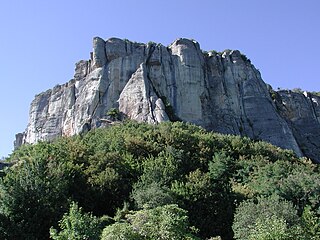
Calcarenite is a type of limestone that is composed predominantly, more than 50 percent, of detrital (transported) sand-size, carbonate grains. The grains consist of sand-size grains of either corals, shells, ooids, intraclasts, pellets, fragments of older limestones and dolomites, other carbonate grains, or some combination of these. Calcarenite is the carbonate equivalent of a sandstone. The term calcarenite was originally proposed in 1903 by Grabau as a part of his calcilutite, calcarenite and calcirudite carbonate classification system based upon the size of the detrital grains composing a limestone. Calcarenites can accumulate in a wide variety of marine and non-marine environments. They can consist of grains of carbonate that have accumulated either as coastal sand dunes (eolianites), beaches, offshore bars and shoals, turbidites, or other depositional settings.

The Columbus Limestone is a mapped bedrock unit consisting primarily of fossiliferous limestone, and it occurs in Ohio, Pennsylvania, and Virginia in the United States, and in Ontario, Canada.
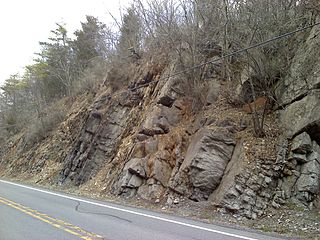
The Late Silurian to Early Devonian Keyser Formation is a mapped limestone bedrock unit in Pennsylvania, Maryland, Virginia, and West Virginia.
Siphonodendron is an extinct genus of colonial rugose corals common during the Carboniferous period. In fossil form it now appears as a white or brown mass of short spaghetti-like threads, usually flattened during distortion of the embedding limestone. It is in the sub-class Hexacorallia of corals with sixfold symmetry.

Isastrea is an extinct genus of corals that lived during the Jurassic and Cretaceous periods. Its fossils have been found in Europe, Africa, North America, Asia and South America.

The Pindai Caves of New Caledonia are an archaeological and palaeontological site important for the study of prehistoric human settlement as well as of the Holocene fauna of the island. The Pindai area has been occupied by humans for varying periods over the last 2,800 years.

Paleontology in Florida refers to paleontological research occurring within or conducted by people from the U.S. state of Florida. Florida has a very rich fossil record spanning from the Eocene to recent times. Florida fossils are often very well preserved.

The Devonian Temple Butte Formation, also called Temple Butte Limestone, outcrops through most of the Grand Canyon of Arizona, USA; it also occurs in southeast Nevada. Within the eastern Grand Canyon, it consists of thin, discontinuous and relatively inconspicuous lenses that fill paleovalleys cut into the underlying Muav Limestone. Within these paleovalleys, it at most, is only about 100 feet (30 m) thick at its maximum. Within the central and western Grand Canyon, the exposures are continuous. However, they tend to merge with cliffs of the much thicker and overlying Redwall Limestone.

















